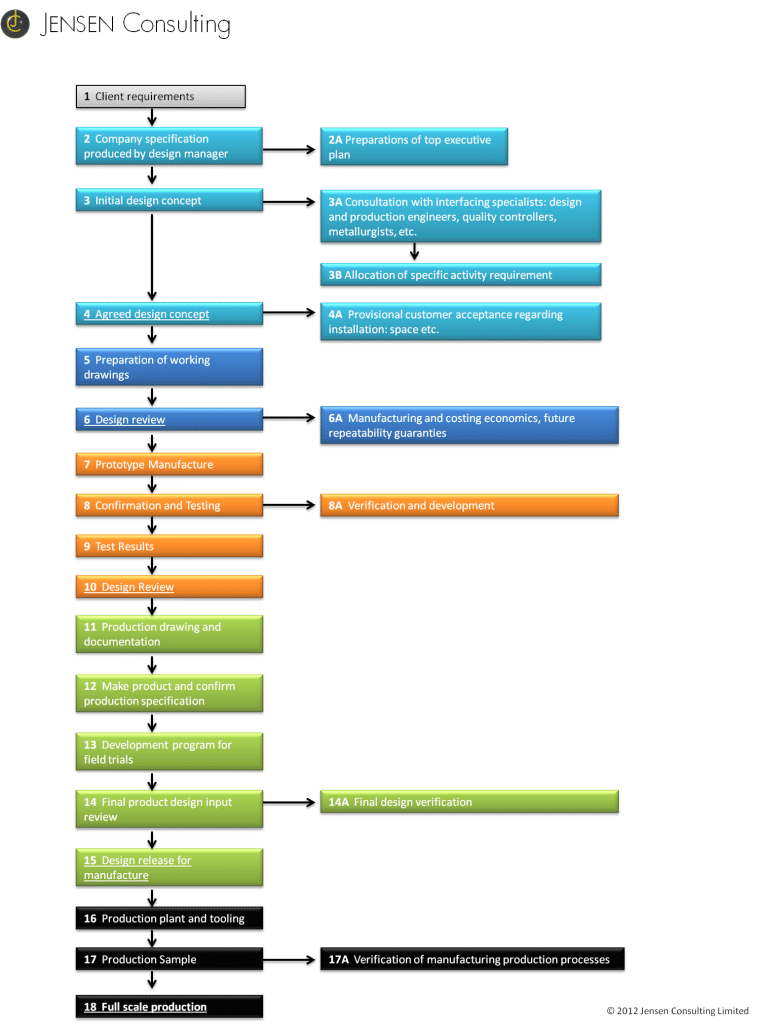Work undertaken by a engineering design service will vary considerably with different branches of industry. Generally, work of a “design and make” nature will follow a plant which sets out stages in development from the time a potential client makes an enqiry until the completed product is delivered. The function of the product will dictate many of the associated activities.
The stages in design and development for components in our typical categories are shown step by step in Figure 1.
Step 1
A client requiring a certain product is often not completely familiar with specific details and needs the experience and advise form a specialist producer to clarify initial ideas. When a range of viable alternatives is presented, opinions can be focused and firm decisions made.
Step 2
The lead engineer or design authority in a company has the responsibility of producing the company specifications for a product including all applicable legislation, which the product will need to, comply with and the levels of configuration control required through the product life cycle. He will not doubt seek advice where aspects of the total design are outside his range of experience, and where design is involved on the fringes of technology. However, a top executive plan needs to be carefully prepared because at the outset the company must know whether or not it wishes to satisfy the client. For example, while rewards may be great, the firm may not be able to cope with the scale of financial and labour demands and delivery requirements in view of current work. They simply may not wish to take the risk and, in view of available production capacity, the firm may prefer not to tender for a possible order.
Step 3
Drawings at this stage should be regarded only as a provisional. The exercise is needed as an aid to think around the problem, with contributions being made by specialists within the firm to ensure feasibility. CAD (computer aided design) has many virtues at his stage of primary design. All information, defined in mathematical terms, can be stored in the system and manipulated on the display. After the basic geometry is established, design variations can be kept, and in redrawing alternatives sections of the previously proposals, which were found be kept, and in redrawing alternatives sections of the previous proposal, which were found to be acceptable can be used repeatedly. At any point in development, the designer can take a printout, so that suggestions and comments can be made by other technical staff. Consideration of the level of configuration control to be applied at this stage is important. In lots of cases the decisions as to why and why not a decision was taken (Optioneering) needs to be formally recorded in some format.
It is essential that the company should appreciate the extent of their commitment if a firm order is accepted at a later date. This commitment includes not only the technical ability to complete the design and manufacture a satisfactory product but also the financial issues relating to its introduction on the factory production line.
Step 4
With the completion of preliminary design work an agreed design concept will be established, but it its necessary to obtain customer approval before work continues. If our product is to be used in conjunction with others in a large assembly, then, for example, expected overall dimensions and operational parameters need to be confirmed with the client before money is spent on further development.
Step 5
If all is well, working drawings will be prepared. These are not production drawings – at this stage, we as a company have only ensured that our proposal are in line with the requirements and that hopefully we shall be able to deliver. The object now is to prepare working drawings to formulate construction methods.
Step 6
A design review is necessary to check the feasibility of manufacturing to ensure that all aspects fo design requirements have been incorporated in an economic manner and to guarantee future supplies.
Step 7
A prototype or small batch may now be manufactured. The ultimate production methods of manufacture will not be employed here. For example, components which may be moulded could be machined from solid to eliminate casting costs.
Step 8
Prototypes are used for testing to make certain that operational requirements of the specification can be achieved. As a result design changes may be necessary. Product tests cover all areas where the component will expected to function without failure, and these could include use in extremism of temperature and humidity, and also when subjected to shock, vibration and fatigue.
Step 9
Proven test results are vital to confirm the validity of these tests.
Step 10
A design review and analysis ensure that progress at this point will be acceptable in every technical aspect and to each responsible member of the team.
Step 11
Production drawing can commence now when the performance targets from the prototype have been confirmed. Drawings of the prototype will be reviewed and modifications made to use full scale production processes during manufacture. For plant to be used efficiently, plans need to be prepared for loading and progressing work through the factory. The necessary documentation now commences.
Step 12
Manufacture of the final product following production of the prototype has involved modifications and different manufacturing processes. It is therefore prudent to check that the specifications can still be kept.
Step 13
Following trials where the equipment is used in its operational environment and its performance exhaustively checked, the design details can be released for full-scale production.
Step 14
Production involves not only the use of machines, but many jigs, fixtures, tools, gauges, inspection procedures need to be planned, and auxiliary equipment designed to move materials on and off production lines.
Sept 15
Inevitable teething troubles occur and samples are taken to verity that all plant and equipment operates as planned. Economic production requires that down time is eliminated before full-scale production commences.



